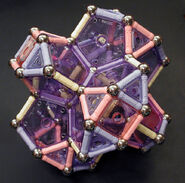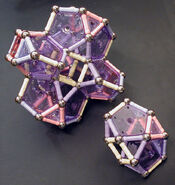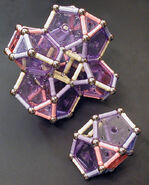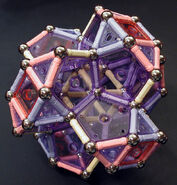| Stewart's J91(P4) | |
 Stewarat's 6J91(P4) | |
| Type | Polyhedron |
| Panels | 24 × 6 × 24 × |
| Rods | 120 × |
| Spheres | 56 × |
| Author | PolyClare 14:44, 14 January 2008 (UTC) |
Stewart's 6J91(P4) -- Six bilunabirotundas (6J91) surrounding a central cube (P4). Although the Geomag model shown at the right retains the inner (yellow) cube inside (for extra stability), this is not part of 6J91(P4).
The bilunabirotunda is known as Johnson Solid J91, and Johnson used the notation P4 for a cube (P for prism, 4 for square). Thus Stewart (page 127, 2nd ed.) labels this complex made from multiple polyhedra 6J91(P4).
The J91(P4) combination is formed by matching a square face of a bilunabirotunda to a side of a cube. Each subsequent bilunabirotunda is attached to another face of the cube, with its long axis oriented orthogonally to the long axes of bilunabirotundas attached to adjacent cube faces. Each bilunarotunda loses a complex of one square surrounded by four triangles in this process, and the cube disappears entirely (though for Geomag model building it may be desirable to retain the cube for extra stability).
This J91(P4) may be used to form the central 6-way hole for the Lunar-holed Rhombicosidodecahedron, Stewart's E5/6J91(P4).
These models were built using Geomag Pastelles. I'm finding that I like using the Pastelles panels for complicated constructions, because their relatively high transparency lets me see more of the entire structure.
Other views[]
Related links & references[]
- Norman W. Johnson, "Convex Solids with Regular Faces", Canadian Journal of Mathematics, 18, 1966, pages 169–200.





